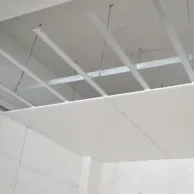Dec . 30, 2024 21:00 Back to list
t bar grid ceiling
Understanding the T-Bar Grid Ceiling An Insight into Modern Architecture
The T-bar grid ceiling, also known as a suspended ceiling or drop ceiling, is an essential component in modern architectural design and construction. This ceiling system has gained popularity for its functional and aesthetic benefits in various commercial and residential settings. In this article, we will explore the characteristics, advantages, applications, and design considerations of T-bar grid ceilings.
What is a T-Bar Grid Ceiling?
A T-bar grid ceiling consists of a framework made of metal that is suspended from the overhead structure. The framework forms a grid pattern, with T shaped runners creating a lattice-like structure. Within this grid, lightweight panels—typically made of acoustic tiles, plasterboard, or mineral fiber—are placed. This assembly forms a ceiling that is not only visually appealing but also offers functional solutions for various spaces.
Advantages of T-Bar Grid Ceilings
1. Aesthetic Versatility The T-bar grid system allows for a wide range of design options. Architects and designers can choose from various tiles and textures to achieve the desired aesthetic appeal. The ability to create different visual effects enhances the interior ambiance of any space.
2. Sound Control One of the primary functions of T-bar grid ceilings is their acoustic performance. Acoustic tiles made from sound-absorbing materials can effectively reduce noise, making them ideal for offices, schools, and other public spaces where sound management is crucial.
3. Easy Access to Utilities The suspended nature of the T-bar grid design provides easy access to electrical, plumbing, and HVAC systems. This accessibility allows for maintenance and modifications without significant disruption to the interior space.
4. Energy Efficiency T-bar grid ceilings can help improve energy efficiency. By incorporating insulation above the grid, these ceilings can help maintain a consistent temperature, reducing heating and cooling costs.
5. Installation and Cost-Effectiveness The installation process for T-bar grid ceilings is relatively straightforward, often requiring less time than traditional plaster ceilings. This ease of installation translates into lower labor costs and a quicker turnaround time for construction projects.
Applications of T-Bar Grid Ceilings
T-bar grid ceilings are widely used in various environments, including
t bar grid ceiling

- Commercial Spaces Offices, retail stores, and restaurants often use T-bar grid ceilings to create a professional and polished look while maintaining functionality.
- Educational Institutions Schools and universities benefit from the acoustic properties of these ceilings, which help create conducive learning environments by minimizing noise disturbances.
- Healthcare Facilities Hospitals and clinics utilize T-bar grid ceilings for their durability and ease of cleaning, as well as their ability to accommodate medical equipment and lighting.
- Residential Projects Homeowners are increasingly adopting T-bar grid ceilings for basements, kitchens, and living areas, appreciating the flexibility and style they offer.
Design Considerations
When designing a T-bar grid ceiling, several factors come into play
- Height Constraints Since T-bar grid ceilings hang below the standard ceiling, it's essential to assess height limitations in a space, particularly in areas with low ceilings.
- Lighting Integration Incorporating lighting fixtures into the grid system can enhance the overall design. Designers should plan for the placement of lights and other utilities harmoniously.
- Acoustic Needs The selection of tiles should align with the acoustic requirements of the space. Areas with high traffic or noise levels often benefit from specialized acoustic tiles.
- Maintenance Accessibility It's crucial to consider how often mechanical systems will need access for maintenance, ensuring that the grid system allows for easy removal of tiles.
Conclusion
The T-bar grid ceiling is more than just a functional element in modern architecture; it represents an intersection of design, utility, and maintenance efficiency. As technology and design philosophies evolve, T-bar grid ceilings will continue to be a staple in diverse settings, catering to the needs of aesthetics and practicality. By understanding its advantages, applications, and design considerations, architects, designers, and homeowners can harness the full potential of this versatile ceiling system, enhancing both the functionality and beauty of their spaces.
-
Quality Ceiling Trap Doors & Access Panels | Easy & Secure AccessNewsAug.30,2025
-
Durable Ceiling T Grid Systems | Easy InstallationNewsAug.29,2025
-
PVC Gypsum Ceiling: Durable, Laminated Tiles for Modern SpacesNewsAug.28,2025
-
Pvc Gypsum Ceiling Is DurableNewsAug.21,2025
-
Mineral Fiber Board Is DurableNewsAug.21,2025
-
Ceiling Tile Clip Reusable DesignNewsAug.21,2025







